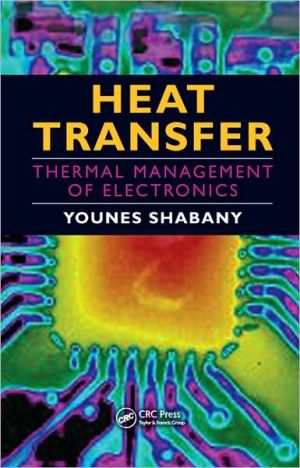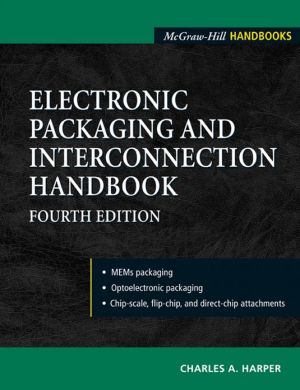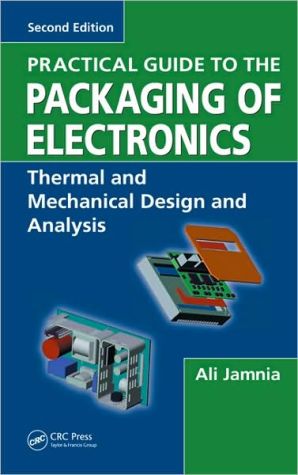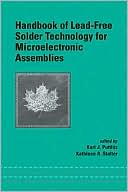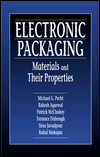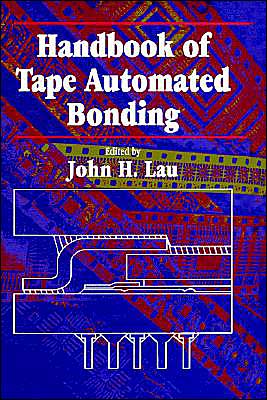Heat Transfer: Thermal Management of Electronics
The continuing trend toward miniaturization and high power density electronics results in a growing interdependency between different fields of engineering. In particular, thermal management has become essential to the design and manufacturing of most electronic systems.\ Heat Transfer: Thermal Management of Electronics details how engineers can use intelligent thermal design to prevent heat-related failures, increase the life expectancy of the system, and reduce emitted noise, energy...
Search in google:
The continuing trend toward miniaturization and high power density electronics results in a growing interdependency between different fields of engineering. In particular, thermal management has become essential to the design and manufacturing of most electronic systems.Heat Transfer: Thermal Management of Electronics details how engineers can use intelligent thermal design to prevent heat-related failures, increase the life expectancy of the system, and reduce emitted noise, energy consumption, cost, and time to market. Appropriate thermal management can also create a significant market differentiation, compared to similar systems. Since there are more design flexibilities in the earlier stages of product design, it would be productive to keep the thermal design in mind as early as the concept and feasibility phase.The author first provides the basic knowledge necessary to understand and solve simple electronic cooling problems. He then delves into more detail about heat transfer fundamentals to give the reader a deeper understanding of the physics of heat transfer. Next, he describes experimental and numerical techniques and tools that are used in a typical thermal design process. The book concludes with a chapter on some advanced cooling methods.With its comprehensive coverage of thermal design, this book can help all engineers to develop the necessary expertise in thermal management of electronics and move a step closer to being a multidisciplinary engineer.
Preface xiiiAbout the Author xvChapter 1 Introduction 11.1 Semiconductor Technology Trends 31.2 Temperature-Dependent Failures 61.2.1 Temperature-Dependent Mechanical Failures 81.2.2 Temperature-Dependent Corrosion Failures 121.2.3 Temperature-Dependent Electrical Failures 121.3 Importance of Heat Transfer in Electronics 131.4 Thermal Design Process 14References 18Chapter 2 Energy, Energy Transfer, and Heat Transfer 192.1 Energy and Work 192.2 Macroscopic and Microscopic Energies 202.3 Energy Transfer and Heat Transfer 242.4 Equation of State 25Problems 28References 28Chapter 3 Principle of Conservation of Energy 293.1 First Law of Thermodynamics 293.2 Energy Balance for a Control Mass 313.3 Energy Balance for a Control Volume 36Problems 44References 51Chapter 4 Heat Transfer Mechanisms 534.1 Conduction Heat Transfer 534.2 Convection Heat Transfer 574.2.1 Simplified Correlations for Convection Heat Transfer in Air 584.3 Radiation Heat Transfer 61Problems 64References 65Chapter 5 Thermal Resistance Network 675.1 Thermal Resistance Concept 675.2 Series Thermal Layers 725.3 Parallel Thermal Layers 755.4 General Resistance Network 795.5 Thermal Contact Resistance 825.6 Thermal Interface Materials 855.7 Spreading Thermal Resistance 885.8 Thermal Resistance of Printed Circuit Boards (PCBs) 91Problems 97References 101Chapter 6 Thermal Specification of Microelectronic Packages 1036.1 Importance of Packaging 1036.2 Packaging Types 1036.3 Thermal Specifications of Microelectronic Packages 1106.3.1 Junction-to-Air Thermal Resistance 1106.3.2Junction-to-Case and Junction-to-Board Thermal Resistances 1126.3.3 Package Thermal Characterization Parameters 1146.4 Package Thermal Resistance Network 1156.5 Parameters Affecting Thermal Characteristics of a Package 1196.5.1 Package Size 1196.5.2 Packaging Material 1196.5.3 Die Size 1196.5.4 Device Power Dissipation 1216.5.5 Air Velocity 1216.5.6 Board Size and Thermal Conductivity 122Problems 123References 125Chapter 7 Fins and Heat Sinks 1277.1 Fin Equation 1277.1.1 Infinitely Long Fin 1307.1.2 Adiabatic Fin Tip 1327.1.3 Convection and Radiation from Fin Tip 1337.1.4 Constant Temperature Fin Tip 1357.2 Fin Thermal Resistance, Effectiveness, and Efficiency 1407.3 Fins with Variable Cross Sections 1467.4 Heat Sink Thermal Resistance, Effectiveness, and Efficiency 1507.5 Heat Sink Manufacturing Processes 160Problems 164References 168Chapter 8 Heat Conduction Equation 1698.1 One-Dimensional Heat Conduction Equation for a Plane Wall 1718.2 General Heat Conduction Equation 1758.3 Boundary and Initial Conditions 1778.3.1 Temperature Boundary Condition 1788.3.2 Heat Flux Boundary Condition 1798.3.3 Convection Boundary Condition 1818.3.4 Radiation Boundary Condition 1838.3.5 General Boundary Condition 1858.3.6 Interface Boundary Condition 1858.4 Steady-State Heat Conduction 1878.4.1 One-Dimensional, Steady-State Heat Conduction 1878.4.2 Two-Dimensional, Steady-State Heat Conduction 1918.5 Transient Heat Conduction 1948.6 Lumped Systems 1968.6.1 Simple Lumped System Analysis 1968.6.2 General Lumped System Analysis 1988.6.3 Validity of Lumped System Analysis 202Problems 204References 208Chapter 9 Fundamentals of Convection Heat Transfer 2099.1 Type of Flows 2099.1.1 External and Internal Flows 2099.1.2 Forced and Natural Convection Flows 2109.1.3 Laminar and Turbulent Flows 2109.1.4 Steady-State and Transient Flows 2129.2 Viscous Force, Velocity Boundary Layer, and Friction Coefficient 2129.3 Temperature Boundary Layer and Convection Heat Transfer Coefficient 2149.4 Conservation Equations 2159.5 Boundary Layer Equations 217References 218Chapter 10 Forced Convection Heat Transfer: External Flows 21910.1 Normalized Boundary Layer Equations 21910.2 Reynolds Number, Prandtl Number, Eckert Number, and Nusselt Number 22110.3 Functional Forms of Friction Coefficient and Convection Heat Transfer Coefficient 22310.4 Flow over Flat Plates 22710.4.1 Laminar Flow over a Flat Plate with Constant Temperature 22710.4.2 Turbulent Flow over a Flat Plate with Uniform Temperature 23410.4.3 Flow over a Flat Plate with Uniform Surface Heat Flux 23710.5 Flow Across Cylinders 23910.6 Cylindrical Pin-Fin Heat Sink 24410.7 Procedure for Solving External Forced Convection Problems 246Problems 248References 253Chapter 11 Forced Convection Heat Transfer: Internal Flows 25511.1 Mean Velocity and Mean Temperature 25511.2 Laminar and Turbulent Pipe Flows 25711.3 Entry Length and Fully Developed Flow 25711.4 Pumping Power and Convection Heat Transfer in Internal Flows 25911.5 Velocity Profiles and Friction Factor Correlations 26311.6 Temperature Profiles and Convection Heat Transfer Correlations 26711.7 Fans and Pumps 27111.7.1 Types of Fans 27111.7.2 Fan Curve and System Impedance Curve 27411.7.3 Fan Selection 27611.7.4 Types of Pumps 27911.8 Plate-Fin Heat Sinks 281Problems 283References 285Chapter 12 Natural Convection Heat Transfer 28712.1 Buoyancy Force and Natural Convection Flows 28712.2 Natural Convection Velocity and Temperature Boundary Layers 29012.3 Normalized Natural Convection Boundary Layer Equations 29112.3.1 Grashof and Rayleigh Numbers 29312.3.2 Functional Form of the Convection Heat Transfer Coefficient 29512.4 Laminar and Turbulent Natural Convection over a Vertical Flat Plate 29612.5 Natural Convection around Inclined and Horizontal Plates 30012.6 Natural Convection around Vertical and Horizontal Cylinders 30312.7 Natural Convection in Enclosures 30412.8 Natural Convection from Array of Vertical Plates 31012.9 Mixed Convection 313Problems 314References 318Chapter 13 Radiation Heat Transfer 31913.1 Radiation Intensity and Emissive Power 32013.2 Blackbody Radiation 32413.3 Radiation Properties of Surfaces 32613.3.1 Surface Emissivity 32613.3.2 Surface Absorptivity 32813.3.3 Surface Reflectivity 32913.3.4 Surface Transmissivity 33013.3.5 Kirchhoff's Law 33113.4 Solar and Atmospheric Radiations 33213.5 Radiosity 33613.6 View Factors 33713.7 Radiation Heat Transfer between Black Bodies 34013.8 Radiation Heat Transfer between Nonblack Bodies 34113.9 Radiation Heat Transfer from a Plate-Fin Heat Sinks 343Problems 349References 350Chapter 14 Computer Simulations and Thermal Design 35114.1 Heat Transfer and Fluid Flow Equations: A Summary 35214.2 Fundamentals of Computer Simulation 35314.2.1 Steady-State, One-Dimensional Heat Conduction 35314.2.2 Steady-State, Two-Dimensional Heat Conduction 35614.2.3 Transient Heat Conduction 35914.2.4 Fluid Flow and Energy Equations 36214.3 Turbulent Flows 37314.4 Solution of Finite-Difference Equations 38014.5 Commercial Thermal Simulation Tools 38114.5.1 Creating the Thermal Model 38214.5.2 Creating the Mesh 39114.5.3 Solving Flow and Temperature Equations 39314.5.4 Review the Results 39614.5.5 Presenting the Results 39714.6 Importance of Modeling and Simulation in Thermal Design 398References 399Chapter 15 Experimental Techniques and Thermal Design 40115.1 Flow Rate Measurement Techniques 40115.2 System Impedance Measurement 40715.3 Fan and Pump Curve Measurements 40915.4 Velocity Measurement Methods 41015.5 Temperature Measurement Techniques 41415.6 Acoustic Noise Measurements 41715.7 Importance of Experimental Measurements in Thermal Design 419References 420Chapter 16 Advanced Cooling Technologies 42116.1 Heat Pipes 42116.1.1 Capillary Limit 42316.1.2 Boiling Limit 42416.1.3 Sonic Limit 42616.1.4 Entrainment Limit 42616.1.5 Other Heat Pipe Performance Limits 42716.1.6 Heat Pipe Applications in Electronic Cooling 42816.1.7 Heat Pipe Selection and Modeling 43016.1.8 Thermosyphons, Loop Heat Pipes, and Vapor Chambers 43516.2 Liquid Cooling 43916.3 Thermoelectric Coolers 44516.4 Electrohydrodynamic Flow 44916.5 Synthetic Jet 450References 452Appendix: Tables of Material Properties 455Index 471
